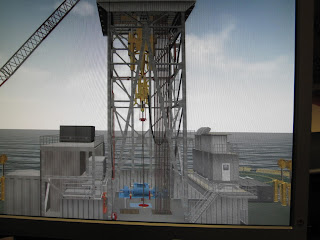The airport,
the international airport still only has one runway but they are making major
changes to the interior amenities in the airport. This is good news because
they will be hosting the World Cup in 2014 and the summer Olympics in 2016. It
takes a tremendous amount of infrastructure to host those two events.
Brazil is
hosting two world-class events. Think
about this in light of the following. Brazil is transitioning into a world-class
country. Yet, there are those subtle things that keep them in the 3rd
world country status.
Consider that they will be moving hundreds of thousands of people through that airport. Everyone has to use the elevators with their luggage. And it is these elevators that fascinate me. In every elevator in this airport, there is a woman who pushes the button for each floor. She sits in a chair in this tiny elevator and that chair takes up a full 33% of the elevator. These are tiny elevators, so that’s saying something. International travelers, jet lag weary from the night flight to Rio, find the presence of these women strangely curious. There is barely room for two people and two suitcases in that conveyance. I understand that these ladies need employment, but how hard can it be to push the buttons for floors one, two and three?????
Consider that they will be moving hundreds of thousands of people through that airport. Everyone has to use the elevators with their luggage. And it is these elevators that fascinate me. In every elevator in this airport, there is a woman who pushes the button for each floor. She sits in a chair in this tiny elevator and that chair takes up a full 33% of the elevator. These are tiny elevators, so that’s saying something. International travelers, jet lag weary from the night flight to Rio, find the presence of these women strangely curious. There is barely room for two people and two suitcases in that conveyance. I understand that these ladies need employment, but how hard can it be to push the buttons for floors one, two and three?????
Drilling for
oil offshore is managed by the boomtown that is Macae a growing city two hours
north of Rio.
This is an extremely labor intensive business. It’s also massively stimulating to the economy.
It takes thousands of people to support that gallon/liter of gasoline in your tank. Think about it: you need, for several hundred oilrigs:
This is an extremely labor intensive business. It’s also massively stimulating to the economy.
It takes thousands of people to support that gallon/liter of gasoline in your tank. Think about it: you need, for several hundred oilrigs:
·
Pipe fits to link each 90’ length of pipe.
·
90’ lengths of pipe that will bring oil to the
surface from over two miles down.
·
Companies that manufacture each 90’ long piece
of pipe. To drill one oil well that is in 7,875 feet of water, plus another
mile underground, so roughly 13,125 feet of pipe or 146, 90’ lengths of pipe.
It’s like sucking oil from a 13,125’ straw. Every single pipe, pipe fitting and
seal have to be perfect.
·
Every single oil rig has a constant turnover
either every 28 days for workers outside of Brazil and every 14 days for
Brazilian workers. There are two crews that constantly change hands.
·
Which means flights, hotels, infrastructure to
handle it all.
·
Then there are the refinery ships, plus two
crews as well that pull up to the wells and pump the oil onto the ships and
then refine it right then and there and then bring it into port.
·
Then of course there are the helicopters that
bring every single thing to the rig except pipe. They fly every day, bringing
food, tools, replacement parts and crewmembers. So imagine the pilots,
maintenance people, and maintenance facilities required to support all of those
choppers. And if the weather is bad, they don’t fly, so everything backs up.
It’s really a nightmare when that happens. (Brazil is a very tropical country,
so it rains quite a bit!)
·
So when that happens, then the crews coming off
the rig can’t fly home, so every single plane reservation, hotel reservation and
driver to pick up the crewmember, have to be changed. Travel is a huge deal.
·
Tools, can you just imagine the replacement parts,
tools, large and small that every single rig needs? They have to be
manufactured, cataloged and stored.
·
Food, all those people on all those rigs have to
eat four times a day because a rig never sleeps. Operations run 24 hours a day.
·
Food, transportation, helos, helo parts, pilots,
cooks, crew members, hotels, housekeeping on the rig, inspectors, all are
repeated and required for all of the hundreds of rigs off the coast of Brazil.
And this
scenario is repeated throughout the world. There are rigs off the coast of
countries everywhere, all requiring all of this support to get that precious
oil out of the ground. We are horrified when one drop of oil hits the water –
and we should be. However, when you consider that there are literally thousands
of oilrigs, drill ships and fuel tankers working day in and day out globally,
the miracle is how few accidents there
are. This is profoundly dangerous work and keeping oil out of the water and
people out of harm’s way is an extremely tense operation. There is absolutely
no room for error.
And these rigs are not anchored to the sea floor. There is no way you can send an anchor a mile into the water. So they are managed by something called Dynamic positioning. The following two photographs are from the TransOcean training center. Lots and lots of training is required to do this astonishing job safely.
And these rigs are not anchored to the sea floor. There is no way you can send an anchor a mile into the water. So they are managed by something called Dynamic positioning. The following two photographs are from the TransOcean training center. Lots and lots of training is required to do this astonishing job safely.
If cars worldwide
ceased needing fuel, we, human beings would still need oil for jet fuel, the
plastic we make everything out of plus lubricating oil. There is, at this time,
no current substitute for machinery/auto/and fine motor lubricating oil.
Plastic, if enough of it was recycled, could make a dent in oil usage, but
lubricating oil is a whole other situation.
It is so expensive to drill in open
ocean for oil that when the price per barrel slips even a bit under $100 a
barrel, it becomes no longer financially feasible to drill for oil. Who knew?
It costs most
oil companies over $550,000 a day to drill for oil. That’s just the drilling
cost. Add to this the cost of actually pumping it out of the ground – which is
a separate cost, refining it at sea and then shipping it to a distribution site
and then trucking it to each gas pump world wide and you begin to get some idea
of why this proposition is so colossally expensive. Of course, once it gets
there, some counties or states add taxes to the price per gallon.
If you’re
thinking we have to come up with a better way to power our western life style –
that would be an understatement! It’s easy to hate the oil companies, even with
all the costs, this is still a moneymaker, but costs are rising and technology
is playing catch up. Consider that the cost of overhauling one oil rig, is
$500,000,000, yep that’s no misprint, five hundred million dollars. Each new
rig costs $750 million a rig. It takes your breath away!
Part 2 Next week!
Part 2 Next week!











No comments:
Post a Comment